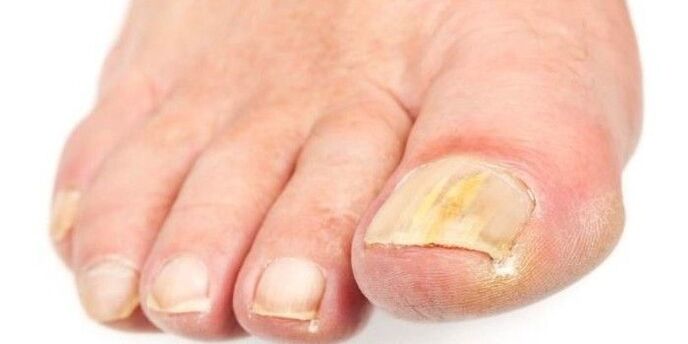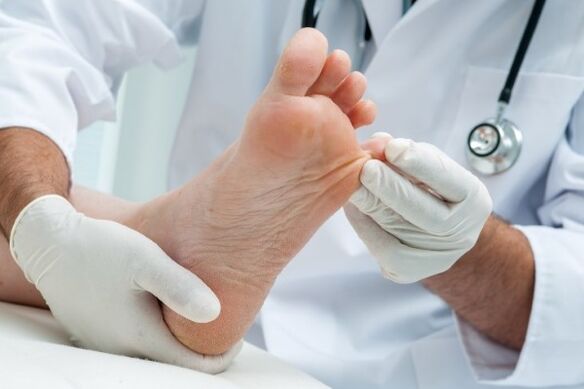The fungus, which is also known as onychomycosis, is an infection of the surface of the nail caused by dermatophytes, yeast or mold.
The color of the nail changes, it gets a whitish tint first, then darker and can smell badly. Thights, deformed, begins to crumble.
There is a high probability that the infection can spread to other nails on the legs and the adjacent skin. Pain will appear when walking and wearing shoes. Therefore, the fungus must be treated in good time.
The causes of nail fungi

The causes of onychomycosis are quite banal:
- Contact with microscopic mushrooms that are everywhere. Another question is that the nails are susceptible to infections when a person goes barefoot in damp places - swimming pools, changing rooms and showers are perfect to absorb the fungus.
- The damaged nail, the cracks, the injured finger, the infection with other bacteria or pus provide a slight penetration from dermatophytes into the body.
- If a person suffers from chronic diseases such as diabetes, peripheral vascular diseases and immune deficiency conditions, a class A candidate is on the legs for a fungal infection.
When there were irritation, the legs sweat a lot and the shoes are tight and ventilated for long periods of poorly ventilated - this is an ideal environment for the growth of disputes.
Symptoms of nail fungus
The most common symptom caused by a fungal infection is the thickening of the plate. The nail can be bleached, white, black, yellow or green.
With the development of the disease, it will break fragile, small nail pieces or can completely separate from the finger. If you are not properly attentive, the skin underneath is swollen, painful, harmful. An unpleasant smell occurs
If the disease does not run, there are usually no other symptoms. Sometimes the body can react to the mushroom in the skin that is free of damage. A rash or itching caused by dermatophytes can be an allergic reaction from the body to a fungus.
Risk factors for the development of nail fungus
Every person can have an infection on the leg finger, but there are certain risk factors that make a person more susceptible to infection with mushroom nails. Some of them are as follows:
- Manufacturing is a predominant risk factor for the occurrence of a nail fungus. When people age, the quality of the blood vessels is reduced and blood supply to the peripheral parts is disturbed, which is why nail growth and general susceptibility to infections are slowed down.
- The male soil tends more for a nail fungus.
- Increased sweating and when a person works in a damp environment, for example delete, wash, clean or cook.
- Wearing socks and shoes prevents the skin from ventilation of the legs, and synthetic material does not absorb sweat, so choose cotton products.
- Contagine risk if you live with a person who has a nail fungus - CO and you can be infected.
- Go barefoot in raw places such as pools, gyms and showers.
- Irritation between fingers, itching, peeling, skin or nail injury, psoriasis.
- Chronic diseases such as diabetes, peripheral vascular diseases, weak immunity and certain syndromes such as Down syndrome.
Complications of the mushroom
A serious infection on the legs can be very painful and lead to constant damage to their nails. If a person has a depressed immune system, diabetes or other chronic diseases, there is a high risk of complications. In diabetes, blood circulation decreases and neuropathy often occurs. Sometimes you can't perceive pain.
Therefore, not only the fungus for the nails, but also a slight injury to the legs can be a serious problem. If a person has diabetes and believes that there is an infection, it is reasonable to visit a doctor.
Test and diagnostics
The infection of the nail fungus is sometimes wrongly diagnosed as psoriasis, contact dermatitis and tumors such as melanoma. To avoid incorrect diagnosis, laboratory tests may be necessary.
As a rule, three approaches are used:
- The first is a smear cooked with potassium hydroxide.
- Second, it is a culture of an infectious organism.
- The third is the histological confirmation of the body.
These three approaches use microscopic examinations of the material from the nails obtained by scrapers or trims.
After a few recent improvements, the most useful direct strokes, the histological examination and the biopsy of the nail plate with the spoon of the periodic acid of the chiff are from the point of view of sensitivity.
In order to correctly diagnose the organisms of the mushroom, several samples may be required.
prevention

The first step that can be taken to prevent fungal infections on the legs is to observe the right hygiene. Pure and dry legs definitely prevent all fungal infections.
Conduct thorough rinsing with soap regularly and do not forget to dry them after the procedure. You have to wear shower shoes in public places.
You may have to change shoes, socks and underwear more than once a day.
Improve nail cutting technology - cut it so that the nails do not go beyond your feet.
Maybe you have to wear shoes that don't fit your fingers firmly and your material should be so that you deliver ventilation.
Avoid wearing cotton or wool socks. Prefer socks from special synthetic fibers that take moisture out of your legs more efficiently than cotton and wool.
Drink nails and pedicure. Do not use paint on the nails with an infection.
When to see a doctor
It is worthwhile to make an appointment with the doctor if your fungal infection of nails causes signs of bacteria: You should check the list of signs and symptoms for the exact diagnosis and the correct selection of medicinal products.
The doctor examines the patient and listens to complaints that primary tests are carried out with the collection of biomaterial in order to determine the type of fungus. Then a complete analysis of the results and the purpose of the therapy.
Treatment and affordable medication
If the fungal infection is mild, there is no complex treatment. However, ignoring can lead to its spread to other nails. In the following you will find treatment options for nail fungus:
Medicines are usually recommended if the infection of mushroom nails is serious.
You may have to take the medication for several months so that the infection has disappeared. The stop of the drug will lead to a relapse too early. Some side effects of medication can include headaches, itching, loss of taste, nausea and diarrhea.
If a person does not want to take pills, the doctor advises to use nail polish instead. It is not as effective as oral products, since it cannot always enter the focus of the infected area deep. The terms of use reach 12 months.
Chemical removal of nails
An unusually looking nail can be chemically removed with a paste with 40% urea. Pasta is slightly available in pharmacies. You have to attach it to the nails, cover it and leave it overnight. Rinse the pasta in the morning and repeat the procedure every day. The infected plate dissolves after about 2 weeks.
This is a painless treatment option that removes the patient with the nail and gradually removes mycosis. With such treatment, it is not necessary for several months to take pills and surgery can be avoided.
Operation and laser therapy
Operation to remove an infected nail is only recommended under difficult conditions if it becomes very painful, and other treatment methods have not helped. After operation, the nail begins to grow again. However, one year may be required for complete recovery.
Is the laser treatment a good option to get rid of nail fungus?
Laser treatment is possible with stubborn infection of the nail. The laser radiates high doses of light energy that kills and destroys the fungus.
According to the investigations, laser therapy is completely safe and the treatment rate is 90% after 3 months. However, it requires repeated every three months a year and is not cheap.
How long can you treat the nail fungus?
Treatment of nail infection can be a long and expensive process.
Periral drugs work on average for about four months, while the infected nail is replaced by healthy.
The treatment duration increases when using antifungales and can take about a year.
The laser and surgical distance delivers faster results.


















